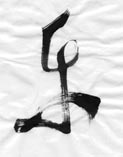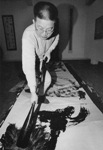Navigation



The Music of Ink:
Chinese arts ancient and modern
A unique event at the British Museum on Saturday 18th June 2005
The Music of Ink will bring together well-known contemporary artists from Beijing, Dublin and London, at the same time as the Museum displays an exhibition of traditional Chinese landscape paintings from its collections ‘Mountains and Water’ (Feb-Aug 2005). In this way, the event will reach not only across culture but also across time, with a particular focus on China.
Our over-riding aim is to explore the creative links between the classical and the contemporary. ‘Classical’ here refers specifically to the Chinese cultural tradition passed down over two thousand years by means of Chinese characters, and by extension, in literature, calligraphy and painting. ‘Contemporary’ refers, in the broadest sense, to contemporary creative work in the arts, both in the East and the West. Contemporary Chinese art is an organic part of the ‘contemporary’ whole. Inspired by contemporary thinking, ‘creative links’ refers to the ‘rediscovery’ of the ancient tradition of Chinese characters, by individual artists from different cultural backgrounds. The question is how these artists are conveying and, more crucially, transforming the very soul of philosophy and the aesthetics of Chinese classical painting, literature and calligraphy in their very contemporary creative work.
At the heart of these exciting transformations and new creations lies the Chinese cultural tradition. Which elements of this rich past offer the most interesting food for thought in today’s world of very different tastes? Which traces of ink, written, painted and drawn in the classical world sing out a new and interesting music today? Hence the name of our event: The Music of Ink.
This is a unique and experimental event. We are embarking on a thoughtful exploration of how a deep and ancient cultural tradition is being consciously renewed and how it remains active and alive in the modern world.
The structure of the event
The event brings together six artists who will perform in pairs. Each pair will consist of one artist originally from China, and one artist from outside the Chinese world. Each pair will take the stage in turn, and open up a conversation in which they will present their own work, explore the other’s work and encourage the audience to join in.
Programme
Opening words (by the Director of the British Museum, tbc)
Session 1: The two literary artists. The conversation will explore the internal nature and inspiration of Chinese characters, how the artist understands and appreciates these qualities and how the understanding becomes part of his own literary creations (with appropriate readings of their work).
YANG Lian (poet, London) and Romesh GUNESEKERA (writer, London)
Session 2: The two visual artists. The conversation will explore the Chinese aesthetic tradition, in particular our understanding of the Chinese landscape tradition, as embodied in the notion that calligraphy and painting share the same source, and how this understanding takes shape in their own visual art works (illustrated with slides/images).
QU Leilei (visual artist, London) and Denis BROWN (visual artist, Dublin)
Break for refreshment
Session 3: A Chinese brush-calligrapher and a UK-based cellist will engage in a conversation without words. The calligrapher will perform calligraphy on the stage, at the same time as the cellist plays his music. The calligrapher and the cellist will create individual works with their own ‘music’ and ‘rhythm’, accompanying, contrasting, conversing, exchanging, as they merge to form one complete ‘work of art’.
ZENG Laide (calligrapher, Beijing) and Rohan DE SARAM (cellist, London)
The Venue
The event will take place in the BM Lecture Theatre at the British Museum (seats 300 people), between 14.00-18.00.
(the following all tbc)
The Clore Centre (the space just outside the theatre) will be prepared as a gallery, displaying calligraphy by the Chinese calligrapher, with a running video of work by the Chinese visual artist and a video of a contemporary play by the Chinese literary artist. There will also be a display of publications by all the artists.
The event will be recorded by video in its entirety. The video can be played on the web (BM website?) and edited after the event.
In this way, the event itself can be transformed into a multi-media work of art, by preserving the concept, the opinions, the physical presentation, performance and behaviour of the event.
In this way, The Music of Ink can become a model for true cultural exchange between East and West.
The literary artists
Yang Lian 杨炼 was born in Switzerland, grew up in Beijing, and now lives in London. He started writing poetry when he was sent to the countryside in the 1970s. On his return to Beijing he became one of the first group of young ‘underground’ Chinese poets, who published the influential literary magazine Jintian. He was invited to Australia and New Zealand in 1988, and became a poet in exile after the Tiananmen massacre. Since then he has continued to write and speak out as a highly individual voice in world literature, politics and culture. He has published seven books of poetry, two books of prose and many essays. He won the Flaiano Prize (Italy, 1999) and his book Where the Sea Stands Still: New Poems won the title ‘Poetry Books Society Recommended Translation’ (UK, 1999). His new book Concentric Circles will be published by Bloodaxe Books in 2005.
Romesh Gunesekera grew up in Sri Lanka and the Philippines, and now lives in London. He is the author of three novels: Heaven’s Edge, The Sandglass and Reef (shortlisted for the 1994 Booker Prize and the Guardian Fiction Prize). His first book, Monkfish Moon (a New York Times Notable Book of the Year), was a collection of short stories. His literary awards include the BBC’s inaugural Asia Award for Writing and Literature, a Yorkshire Post Book Award, a Premio Mondello Five Continents award in Italy and several poetry prizes. In 2003 he visited China as a member of the British Council’s Writers’ Train as one of four British writers on a 10,000 km journey around China with four Chinese writers. www.romeshgunesekera.com
The visual artists
Qu Leilei 曲磊磊 was born in Heilongjiang, China, and now lives in London. In 1979 he was a founding member of the Stars Art Movement, the influential group of artists who fought for freedom of expression within the arts after the Cultural Revolution. He published a selection of his striking early work in A Visual Diary (1996).He came to London in 1985, and has spent the past twenty years studying, creating new works, lecturing and exhibiting worldwide. He has recently published three books: The Simple Art of Chinese Calligraphy (2002), The Simple Art of Chinese Brush Painting (2004) and The Simple Art of Tai Chi (2004). In March 2005 his paintings will be displayed at the Ashmolean Museum, Oxford, at the solo exhibition ‘Everyone’s life is an epic’.
Denis Brown was born in Dublin and still lives there. Inspired by the heritage of Irish manuscripts such as The Book of Kells, he embarked on a rigorous formal training in traditional calligraphy at the Roehampton Institute, London. In 1988 he was elected as a Fellow of the Society of Scribes and Illuminators, London: the first Fellow from Ireland and, at twenty years of age, the youngest Fellow in the history of the SSI. He is now producing experimental work: both in glass and digital format. He has has won awards and commissions on four continents, and is internationally recognized as a world leader in the field of letter arts. www.quillskill.com
The performing artists
Zeng Laide 曾来德 was born in Sichuan, and, after years in the army in northwestern China, now lives in Beijing. He began to study calligraphy in 1980, and has since become one of China’s most dynamic and innovative calligraphers. His work was the subject of a film ‘The Army’s Inkman’ (1986), also translated into English, French, German, Japanese and Spanish. After a solo exhibition at the National Art Gallery, Beijing, in 1989, his calligraphy has been exhibited widely, most recently in an exhibition touring throughout China in 2003-2004. In 1999 he set up the Zeng Laide Arts Centre in Beijing, from where he now works. For the British Museum’s ‘Music of Ink’ event he will make a special performance of brush-calligraphy to string-music.
Rohan De Saram was born in Britain, and now lives in London. One of the world’s leading cellists, particularly in contemporary music, his career spans several decades. His first solo concert, aged just sixteen, was at the Royal Festival Hall, London. He made his debut at the Carnegie Hall, New York, in 1959 playing Khatchaturian’s cello concerto. He is particularly interested in contemporary music, and plays solo; with his pianist brother Druvi de Saram; as a Member of the De Saram Clarinet Trio; as a Member of the Arditti Quartet and as a Member of AMM (improvised music).